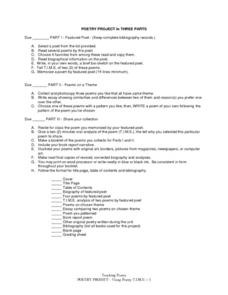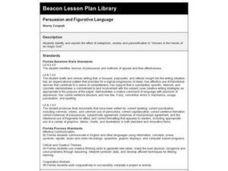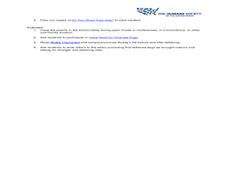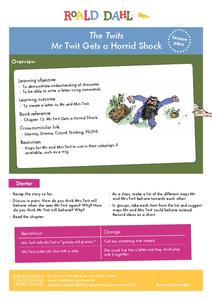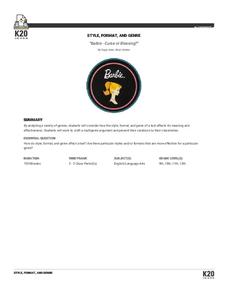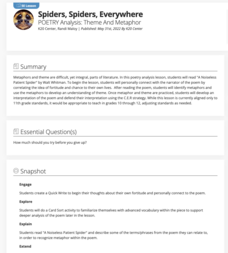Teaching English
Poetry Project in Three Parts
It’s poetry T.I.M.E! Individuals use the T.I.M.E. format (T = Title, thought, and theme; I = Imagery and figurative language; M = music and sound; E = emotion) to study a poet, collect poems that have a similar theme, and create a...
Curated OER
Metaphors
For this figurative language worksheet, students discover what metaphors are as they read a description and then identify the meanings of the metaphors in 7 sentences.
Curated OER
Persuasion and Figurative Language
Students study and discuss definitions of metaphor, simile, and personification. In small groups, they read a section of "Sinners in the Hands of an Angry God" and identify those devices. The group presents their examples with the class.
Curated OER
Figurative Language: simile
In this simile learning exercise, students fill in the blanks to similes about themselves. Students complete 6 similes total on this learning exercise.
Curated OER
Poetic Justice: Understanding the Life of a Tethered Dog
The Humane Society provides a lesson in which class members explore the issue of tethering dogs. Through the resources used -- a comic, a poem, and narrative and expository writings -- class members realize that messages can be conveyed...
Soft Schools
Onomatopoeia in Literature
Identifying onomatopoeia is one thing; making an inference about the significance of the sound is more advanced. Young poets read a literary passage and identify the examples of onomatopoeia in each before naming the source of the sound.
Poetry4kids
How to Write an Alliteration Poem
Learners follow five steps to compose an alliteration poem. They choose one consonant and brainstorm as many nouns, verbs, and adjectives they can think of to create rhyming sentences that come together in a poetic fashion.
Curated OER
Charles Darwin Meets John Paul II
If you teach AP English language and composition and are looking for a way to address the differences between written and spoken arguments, consider this lesson. Over the course of three days, class members research Charles Darwin or...
Prestwick House
Rhetorical Devices in Political Speeches
Have you ever watched a political speech and felt your heart beat a little faster, and your opinion either solidify or begin to slightly change? Rhetorical devices can be a strong tool in an effective and powerful speech. A short lesson...
Roald Dahl
The Twits - Mr Twit Gets a Horrid Shock
Mr. and Mrs. Twit do not treat each other very nicely. The sixth lesson in an 11-part unit designed to accompany The Twits by Roald Dahl explores the way the characters talk to and treat one another. Role play and writing activities...
Geography 360°
Poetry Writing
Put the tips and tricks in this guide into practice in order to encourage your pupils to blossom into poets. A wonderful reference material for teachers, this packet includes definitions of poetic terms and forms as well as step-by-step...
abcteach
Snow Similes
The snowflakes were like diamonds, glittering on the ground and in the sky. Encourage your pupils to write their own snow-related similes with a quick exercise. Pupils write five similes and illustrate their favorite comparison.
Student Achievement Partners
Eleven
Turning 11 comes with a range of emotions. Explore those emotions by reading the short story "Eleven" by Sandra Cisneros. Readers analyze the main character's reactions to the events of her day. Then, they write an essay describing what...
University of Oklahoma
Barbie™: Blessing or Curse? - Style, Format, and Genre
Barbie has been an iconic figure in the lives of girls since the 1950s, but her existence has been full of controversy. A lesson plan on style, format, and genre explores that controversy by looking at three texts with different...
K20 LEARN
Sweet and Savory Writing: Descriptive Writing
The engagement is in the details. Young scholars learn the benefit of weaving descriptive and sensory details into the fabric of their writing through the activities in this lesson. As their hands explore items concealed in bags, a...
Texas Education Agency (TEA)
Paradox (English III Reading)
Pairs of contradictory words introduce learners to paradoxes, the literary device writers use to get readers thinking deeply about their messages. An interactive lesson uses poems by Emily Dickinson and Wilfred Owen and excerpts from the...
K20 LEARN
Spiders, Spiders, Everywhere: Poetry Analysis - Theme And Metaphor
Walt Whitman's poem "A Noiseless Patient Spider" provides high schoolers an opportunity to reflect on the importance of perseverance and fortitude. After drafting a Quick Write about a time they tried and tried again to accomplish...
Simon & Schuster
Classroom Activities for The Odyssey by Homer
A 15-page packet details three activities designed to engage scholars in Homer's The Odyssey. As they read, pupils use a graphic organizer to record examples of several literary terms found in The Odyssey and contemporary culture. Groups...
K20 LEARN
It’s Never Too Late to Apologize: Character Development and Theme in “The Scarlet Ibis”
Sometimes saying I'm sorry just doesn't cut it. Scholars examine a series of apology poems, songs, and stories and consider each speaker's regrets. Using what they have learned, they analyze James Hurst's short story, "The Scarlet Ibis,"...
Curated OER
A Rose Is a Rose
Flowering learners explore the concept of figurative language as it relates to poems, songs, or creative written expression. In this creative writing lesson, they complete several phrases using similes, metaphors, and personifications. ...
Curated OER
Blanket the Plains
Learners discuss vivid imagery in a story. In this figurative language lesson plan, students read samples of sensory language and then discuss the meaning of a piece of figurative language. Learners provide examples.
Curated OER
Body Language
Students take pictures in different settings to demonstrate the importance and influence of body language. In this body language lesson plan, students use a camera and work in groups over a 5 week period.
Curriculum Corner
ELA Common Core Checklists for K-6
In the hustle and bustle of life in the classroom, it's easy for teachers to lose track of the standards they have taught, and those that still need to be addressed. This Common Core checklist provides educators with an easy-to-use...
1 plus 1 plus 1 equals 1
I Can Read! Sight Words Set #16
Now, there, of, and say are the sight words in focus in a printable packet in which you can use all, or some, of the activities to reinforce your early readers' sight word proficiency.


